by Claudia Viggiani
translated by Steve Barley
There are works of art which grasp you, capture you, which leave you defenseless, unable to breathe.
Like The Rape of Proserpina by Gian Lorenzo Bernini.
Go into the great and splendid hall of the Borghese Gallery, at the centre of which stands this work of art, and you see nothing else.
You do not see the walls lined with precious marble and minute mosaics. You do not see the sculptures and furnishings which occupy the space around you.
You just try to reach the statue as quickly as you can and when you do, you are looking at a static, white mass thrashing violently in front of you.
You lose control of your emotions and , if you could, you would cry.
Because Beauty is this. Not existing, but feeling. Contemplating only what enthralls and captivates most.
He who wants to see, sees. And words are meaningless. Only silence. And the profundity of our gaze, of that feeling which is strength, pure energy, within us.
And then, the tears. Those two tear drops which slowly trickle down her cheek which make you understand the absolute significance of the work.
The atavistic pain of abduction, of rape and the wretched absence of freedom which follows.
The anguish of the knowledge that you will never be the same again.
This desperate, inconsolable pain is contained in those two tears and in the sound of a voice that you cannot hear and in leaving Proserpina, who you want to help, to set free, but are powerless to do so, because it is already over. It is done and Bernini has merely sculpted it.





